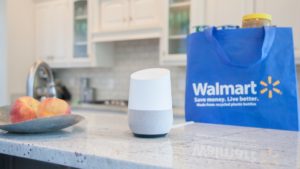Voice shopping is expected to jump to $40 billion in 2022, up from $2 billion today, suggesting the new channel may well be the next major disruptive force in retail, according to data from OC&C Strategy Consultants.
shopping is expected to jump to $40 billion in 2022, up from $2 billion today, suggesting the new channel may well be the next major disruptive force in retail, according to data from OC&C Strategy Consultants.
The survey showed growth in the voice segment will be driven by a surge in the number of homes using smart speakers, rising to 55% from 13% percent today. Meanwhile, Amazon is poised to dominate the new channel with the largest market share, currently more than twice that of its nearest competitor.
Among other key findings of the study:
- Three tech behemoths lead the virtual assistant AI space in the US – Amazon’s Echo has 10% penetration of US homes; Google’s Home, 4%, and Microsoft’s Cortana, 2%.
- Apple has been left behind. Siri lacks the AI capabilities of Google, while their HomePod has only just hit the market.
- Only 39% of consumers trust in the “personalized” product selection of smart speakers.
- Smart speaker owners skew younger and more affluent, and are more likely to have children.
- Voice purchases tend to be stand-alone, lower value items.
- The three most commonly shopped categories through voice are commoditized: grocery (20%), entertainment (19%) and electronics (17%). Clothing is fourth at 8%.
Amazon Wields the Most Power in Voice Shopping
“Amazon Choice” status will be more important than ever. Those products that attain Amazon “Choice” status typically realize a sales boost of more than 3X. Losing Amazon “Choice” status typically leads to a 30% reduction in sales.
Amazon has a firm hold over consumers’ buying decisions, with 85% of consumers selecting the products Amazon suggests.
Currently, 45% of grocery orders replace existing store or online purchases, the vast majority are made through Amazon Fresh.
Retailers Need to Adapt to Succeed in Voice Shopping
Retailers must develop “skills,” or connected applications, that integrate into current voice offers. There are currently only 39 such apps within the voice shopping category.
To drive additional spending and higher price points, retailers should provide inspiration in the form of new recipes, for example.
Building trust has a direct correlation with overall ratings. Only 39% of consumers trust in the “personalized” product selection of smart speakers and only 44% believe they offer the best value selection of products.
How Consumer Packaged Goods Can Succeed
Consumer goods businesses must maintain Amazon’s “Choice” status, even though Amazon’s “Choice” products changes frequently (4-5% daily) due to stock or delivery speed issues.
Ensuring that products are easy to find is critical, as 69% of customers know the exact product they wish to buy.
Tailoring search terms to insure distinctiveness (e.g., “sensitive toothpaste”) increases the chances that a product will be “found.”
John Franklin, Associate Partner, OC&C, commented: “Voice commerce represents the next major disruption in the retail industry, and just as e-commerce and mobile commerce changed the retail landscape, shopping through smart speaker promises to do the same. The speed with which consumers are adopting smart speakers will translate into a number of opportunities and even more challenges for traditional retailers and consumer products companies.”
Coye Nokes, Partner, OC&C, noted: “In order to properly position themselves, retailers must ask themselves key questions, such as: What objectives am I trying to meet? How should I tailor my voice proposition to meet those objectives? Which AI system is best suited to enabling those objectives? How can I build consumer trust in my product recommendations? How can I make the order economics work? The companies that are able to answer those questions most clearly are likely to be the winners in this next phase of retail disruption.”
Source: OC&C Strategy Consultants

You must be logged in to post a comment Login